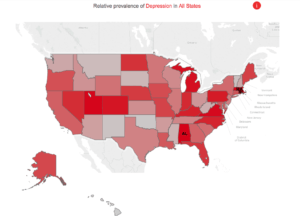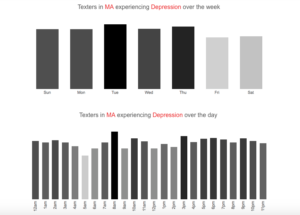Crisis Text Line: Saving Lives Through Data

Non-profits aren’t known for being particularly data-driven. Crisis Text Line, however, views itself as a tech company first, helping folks with mental health challenges; it just so happens to be a non-profit. It has now amassed the most comprehensive real-time mental health data set to date.[1]
Crisis Text Line is a non-profit organization that offers free support 24/7 via text message to people facing a crisis. Founded in 2013, the organization was birthed out of DoSomething.org, a text-based non-profit organization that connects teens with volunteer opportunities. The catalyst for the organization’s creation was that some teens were responding to calls for volunteers with messages crying out for help. In particular, a respondent asserted that she was being regularly raped by a family member and didn’t know what to do. DoSomething.org staff felt like they had to truly do something.
The victim could have called one of many crisis hotlines; however, there wasn’t a way to text one. Teens, in particular, significantly favor texting over calling as a means of communication and texting provides a different level of privacy than calling. Additionally, “people are more likely to disclose sensitive information via text message than in voice interviews.” [2] Accordingly, it was then obvious that there was a real opportunity to address mental health issues facing teens in a new fashion.
Since Crisis Text Line was established, over 34 million text messages have been exchanged, and it only took four months for the line to receive text messages from all 295 area codes in America.[3, 4] Consequently, the organization has amassed a huge amount of real-time, mid-crisis data – an unparalleled data set in the mental health field.[5] In contrast, other data are typically captured post-crisis, when memories can be biased or tarnished. The text based nature of the service is also advantageous as it allows for easy data capture (e.g. time, geography, language). The data is completely anonymized upon collection and counselors don’t have access to the texter’s contact information. Neither party is billed for the correspondence (as a result of an agreement with national cellphone carriers like Verizon and AT&T), and the conversation isn’t even noted on the texter’s phone bills.
Harnessing and analyzing the data has been a key focus for the organization from its inception: the second hire was a Chief Data Scientist.[6] Data helps to modify and optimize crisis-counseling practices and enables the organization to more efficiently and effectively help those in crisis. For instance, Crisis Text Line has found that first-person responses are more effective in helping people “cool down” from a “hot moment.”[7] Also, based on a text’s language, Crisis Text Line’s algorithm can help predict the crisis’ severity level and place that person in the number one slot in the queue, similar to how triage works in hospitals. Lastly, because there’s only one number to text (versus crisis-specific hotlines), people in crisis don’t have to overthink which number to text. The organization and algorithm also benefit by being able to centrally aggregate and, in turn leverage, a variety of data.
Crisis Trends is Crisis Text Line’s sister effort, which helps to educate the public about mental health trends. Researchers, who want to delve deeper into more granular data, can gain access to it by affiliating with a university or research organization and having proper IRB (Institutional Review Board) approval. There are three types of data available: conversation level, actor level, and message level.[8] The aim is that this data set will help the public and policy leaders better address mental health challenges and improve people’s lives. Learn More Here.
Although Crisis Text Line and Crisis Trends don’t capture value in a traditional manner (i.e. monetization), the data helps to drive the organization’s operational efforts. For instance, knowing that “depression peaks at 8 p.m., anxiety at 11 p.m., self-harm at 4 a.m., and substance abuse at 5 a.m.” can help the organization appropriately staff employees and volunteers, which in turns helps to streamline costs.[9] Since data can help control costs, the burden of fundraising is lessened. Lastly, value is captured via social impact (i.e. lives saved and bettered as a result of the service). Crisis Text Line serves hundreds of folks daily and, on average, has eight “live rescues” a day.[10] The service also is more accessible to the hearing impaired and deaf, relative to other crisis services available.
Future Opportunities
Looking to the future, the organization hopes to generate greater awareness, onboard more highly trained volunteers, and grow to international markets.
https://www.facebook.com/Dose/videos/1314300228664512/
—
Footnotes / Sources:
[1] https://blogs.microsoft.com/bayarea/2016/11/30/how-crisis-text-line-is-harnessing-data-to-improve-mental-health-support-in-the-bay-area
[2] http://www.newyorker.com/magazine/2015/02/09/r-u
[3] http://crisistrends.org
[4] http://www.newyorker.com/magazine/2015/02/09/r-u
[5] Ibid.
[6] Ibid.
[7] Ibid.
[8] http://www.mobihealthnews.com/content/crisis-text-line-opens-its-mental-health-texting-data-set-researchers
[9] http://www.newyorker.com/magazine/2015/02/09/r-u
[10] http://mashable.com/2016/05/28/crisis-text-line/#Bgua4OBg4Eq2





Really great post Lauren, thank you. Regarding future opportunities, what are ways they could leverage their dataset, other than operational cost savings and triage that you cited? Might be really interesting to further partner with Verizon/AT&T to pair with demographic and/or app usage data to conduct even more granular anonymized mental health research. Of course, some form of differential privacy would be important.
This is so fascinating and such a great cause. I just wonder if they have or will encounter any regulatory hurdles since they’re essentially entering the mental health space and there could be a huge liability risk. I’m also curious how they think about “post crisis care” – if someone is struggling with depression or an eating disorder etc, it’s one thing to walk them away from the brink and another to really help them through recovery or guide them to those resources. Do they have any metrics on post-intervention “success” rates? I know that this is something a lot of mental health providers and rehab centers struggle to quantify.
Thanks so much for writing about this, Lauren! Since your discussion in class, I’ve been thinking a lot about the comment above regarding regulatory hurdles and data privacy concerns related to this model. I wrote my post about a data company in the education space that failed because there were such strong pro-privacy political winds working against it. My hypothesis is that parents and legislators feel particularly strong about student data, because students are considered a vulnerable population that need to be protected. I imagine you could say the same for users of the Crisis Text Line. Do you know if they’ve faced strong political/legislative obstacles, and if so, how they’ve been able to assuage those concerns? (There may be learnings for the education space!)